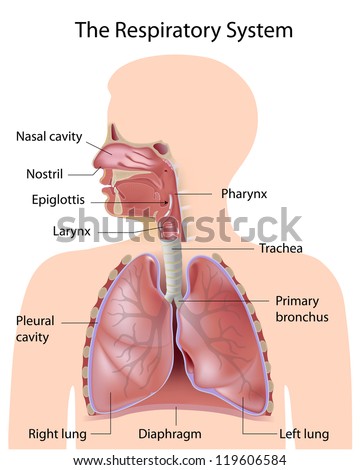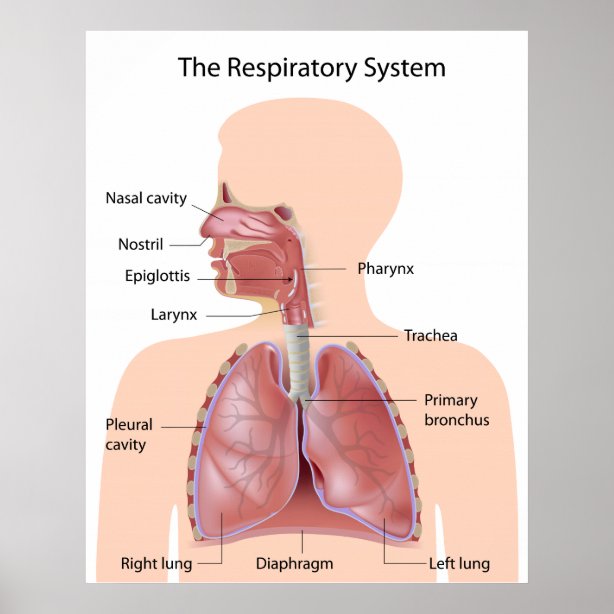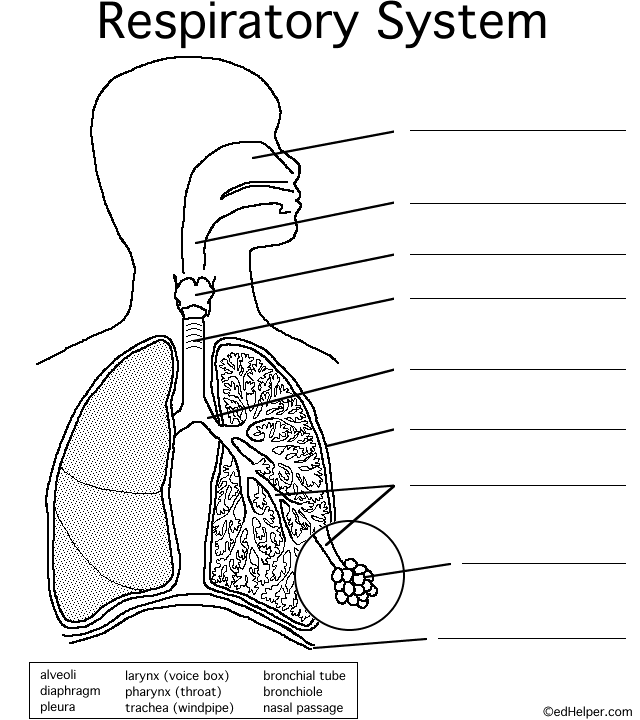41 respiratory system with labels and functions
› enforcement › directivesInspection procedures for the Respiratory Protection Standard ... Sep 25, 1998 · Respiratory Protection Program-1910.134(c)(1): A written respiratory protection program is required when necessary to protect the health of the employee from workplace contaminants or when the employer requires the use of respirators. A limited written program is also required when respirators (other than filtering facepieces) are being ... Respiratory System Anatomy and Physiology - Nurseslabs The functions of the respiratory system are: Oxygen supplier. The job of the respiratory system is to keep the body constantly supplied with oxygen. Elimination. Elimination of carbon dioxide. Gas exchange. The respiratory system organs oversee the gas exchanges that occur between the blood and the external environment. Passageway.
quizlet.com › 620847462 › autonomic-system-flash-cardsAutonomic system Flashcards | Quizlet Primitive functions, such as blood pressure, heart rate, body temperature, metabolism, and respiratory airflow, are regulated by visceral reflexes. The autonomic nervous system quietly manages a myriad of unconscious processes responsible for the body's homeostasis.

Respiratory system with labels and functions
Structure of the Human Respiratory System Explicated With Diagrams The human respiratory system is composed of the nasal passages, the pharynx, larynx, the trachea, bronchi, and the lungs. It is responsible for the process of respiration that is vital to the survival of living beings. Respiration is the process of obtaining and using oxygen, while eliminating carbon dioxide. Functions of human respiratory system - telanganatoday.com Such an arrangement is essential for breathing, as we cannot directly alter the pulmonary volume. • Respiration involves the following steps: Breathing or pulmonary ventilation by which atmospheric air is drawn in and CO2 rich alveolar air is released out. Diffusion of gases (O2 and CO2) across alveolar membrane. Respiratory System - Medical Terminology for Healthcare Professions A bronchial tree (or respiratory tree) is the collective term used for these multiple-branched bronchi. The main function of the bronchi, like other conducting zone structures, is to provide a passageway for air to move into and out of each lung. The mucous membrane traps debris and pathogens.
Respiratory system with labels and functions. Organs of the Respiratory System And Their Functioning They carry out the work of supplying the body with oxygen and removing carbon dioxide. 1. The left lung is divided into 2 lobes (superior and inferior) while the right lung into 3 (superior, inferior and middle). 2. Each lung possesses a triangular organ called hilum; blood vessels, nerves, lymphatics and bronchi pass through the hilum. Alveoli Respiratory System Anatomy, Diagram & Function | Healthline The respiratory system, which includes air passages, pulmonary vessels, the lungs, and breathing muscles, aids the body in the exchange of gases between the air and blood, and between the blood and... Human Respiratory System - Toppr Ask The figure shows a diagrammatic view of human respiratory system with labels A, B, C and D. Select the option which gives correct identification and main function and/ or characteristic. A A- Trachea- long tube supported by complete cartilaginous rings for conducting inspired air. B What is the Respiratory System: Diagram and Function Respiratory System Functions During inspiration, the rib cage moves outwards and upwards and the diaphragm lowers increasing the volume of the thoracic cavity. This causes the internal pressure in the lungs to be lower than the atmospheric pressure. The difference in pressure forces air (introducing oxygen to the alveoli) in to the lungs.
Human Respiratory System - BYJUS The functions of the human respiratory system are as follows: Inhalation and Exhalation. The respiratory system helps in breathing (also known as pulmonary ventilation.) The air inhaled through the nose moves through the pharynx, larynx, trachea and into the lungs. The air is exhaled back through the same pathway. The Respiratory System - Structure And Function | Biomedical ... The lungs encompass the entire system of tubes branching out from the main bronchi to the alveoli. Measuring the functioning of the lungs is a medical tool for diagnosing problems in the respiratory system. Measurements of lung function 2. Air volume (in liters) - lung capacity. Maximum lung volume is known as TLC (total lung capacity). It ... › panoramic › indexPharmaCircle This website uses cookies to help provide you with the best possible online experience. Please read our Terms & Conditions and Privacy Policy for information about ... 13.2 Structure and Function of the Respiratory System Upper respiratory tract organs provide a route for air to move between the outside atmosphere and the lungs. They also clean, humidify, and warm the incoming air. No gas exchange occurs in these organs. Nasal Cavity The nasal cavity is a large, air-filled space in the above and behind the nose in the middle of the face.
Functions of human respiratory system - telanganatoday.com Breathing or pulmonary ventilation by which atmospheric air is drawn in and CO2 rich alveolar air is released out. Diffusion of gases (O2 and CO2) across alveolar membrane. Transport of gases by the blood. Diffusion of O2 and CO2 between blood and tissues. Utilisation of O2 by the cells for catabolic reactions and resultant release of CO2. Upper Respiratory Tract: Anatomy, Functions, Diagram Upper Respiratory Tract Structural and Functional Anatomy Nose and Nasal Cavity. The nostrils, the two round or oval holes below the external nose, are the primary entrance into the human respiratory system [5].Lying just after the nostrils are the two nasal cavities, lined with mucous membrane, and tiny hair-like projections called cilia [6].During inhalation, the air passes into the nasal ... Respiratory System: Function & Physiology - Study.com The process of respiration begins at the nose and mouth, where air enters your body. You inhale and air travels down the back of the throat, the larynx, and into the trachea, a tube that runs down ... 5 Functions of Respiratory System | Respiratory Anatomy The following are the five key functions of the respiratory system. 1. Inhalation and Exhalation Are Pulmonary Ventilation—That's Breathing The respiratory system aids in breathing, also called pulmonary ventilation. In pulmonary ventilation, air is inhaled through the nasal and oral cavities (the nose and mouth).
Respiratory system: Anatomy and functions | Kenhub The main function of the respiratory system is pulmonary ventilation, which is the movement of air between the atmosphere and the lung by inspiration and expiration driven by the respiratory muscles. The respiratory system works as a whole to extract the oxygen from the inhaled air and eliminate the carbon dioxide from the body by exhalation. The upper respiratory mainly has an air-conducting function, while the lower respiratory tract serves both the conducting and respiratory functions.
Respiratory system - Wikipedia The respiratory system in plants includes anatomical features such as stomata, that are found in various parts of the plant. Contents 1 Mammals 1.1 Anatomy 1.2 Ventilatory volumes 1.3 Mechanics of breathing 1.4 Gas exchange 1.5 Control of ventilation 1.6 Responses to low atmospheric pressures 1.7 Other functions of the lungs 1.7.1 Local defenses
Respiratory system diagram: Function, facts, conditions, and more The respiratory system allows people to breathe. It is made up of several organs and structures that transport air into and out of the lungs, exchanging oxygen with carbon dioxide. While the...

Respiratory System Not Labeled Black And White Respiratory System Diagram Unlabeled – Human Ana ...
Respiratory System - Definition, Function and Parts - Biology Dictionary Respiratory System Structure. The organs described above work as a functional unit within the respiratory system. Air is taken in through the mouth and nose. From here, it makes its way down the trachea. The trachea splits into the bronchi of each lung, where it further divides into a number of smaller tubes that lead to the alveoli. These tiny sacs within the lung are the actual sites of gas exchange.
The Respiratory System - Diagram, Structure & Function The function of the human respiratory system is to transport air into the lungs and to facilitate the diffusion of oxygen into the bloodstream. It also receives waste Carbon Dioxide from the blood and exhales it. Here we explain the anatomy of the airways and how oxygen gets into the blood.
Human Respiratory System - Diagram, Features, Parts and Functions - VEDANTU Internal respiration, another important function of the respiratory system, transports oxygen to cells and eliminates waste carbon dioxide. Red blood cells transport oxygen received from the lungs around the body via the vasculature in this respiratory process. When oxygenated blood enters the small capillaries, red blood cells release oxygen.
Respiratory system structure and function - BBC Bitesize Respiratory system structure and function Passage of air into the lungs Air enters the body and is warmed as it travels through the mouth and nose. It then enters the trachea. The trachea divides...
Functions of the Respiratory System The respiratory system consists of multiple bones and cartilaginous structures which all help to protect the soft tissues of the respiratory organs [7]. The perpendicular plate of ethmoid forms the wall that separates the nasal cavity into two sections while the maxilla, palatine bone, nasal bones, and concha all help to form the insides of the nasal cavity and help the inhaled air move in the right direction.
human respiratory system | Description, Parts, Function, & Facts human respiratory system, the system in humans that takes up oxygen and expels carbon dioxide. The design of the respiratory system The human gas-exchanging organ, the lung, is located in the thorax, where its delicate tissues are protected by the bony and muscular thoracic cage.
Respiratory System • Anatomy, Parts & Functions Respiratory System Anatomy - Major Zones & Divisions. The respiratory is separated into the conducting zone and the respiratory zone. The conducting zone include structures that facilitate air to move in and out of the lungs. The respiratory zone allow inhaled oxygen to diffuse into the lung capillaries in exchange for carbon dioxide.
Respiratory System Organs and Their Functions - New Health Advisor Respiratory System Organs and Their Functions The respiratory system plays a vital role in the body, by providing your cells with much needed oxygen, as well as excreting carbon dioxide, which can be deadly if allowed to accumulate. Major parts of the system include the airways, the lungs, and the muscles of respiration.
medcell.med.yale.edu › histology › immune_system_labHistology - Yale University The immune system is important for the elimination of harmful foreign pathogens, which it achieves via its ability to distinguish self from non-self. A broad spectrum of pathology may result when the system is not functioning properly; some of the examples include immunodeficiency, autoimmunity, and hypersensitivity.
quizlet.com › 574287764 › apr-lymphatic-system-flashAPR Lymphatic System Flashcards - Quizlet This return of fluid is also assisted by the respiratory pump which generates low pressure in the thoracic cavity and high pressure in the abdominal cavity. The lymph then is moved from the lymphatic vessels to the blood vessels.
opentextbooks.concordia.ca › fundamentalsofhealth3.3.1. The Cardiovascular and Respiratory System ... Because the heart and lungs are so interlocked in this process, the two systems are often labeled together as the cardiorespiratory system. Without a healthy respiratory system, the body would struggle to bring in enough oxygen, release carbon dioxide (the chemical waste product of cellular metabolism) and eliminate unwanted particles that ...
Respiratory System: Functions, Facts, Organs & Anatomy Your respiratory system is the network of organs and tissues that help you breathe. This system helps your body absorb oxygen from the air so your organs can work. It also cleans waste gases, such as carbon dioxide, from your blood. Common problems include allergies, diseases or infections. Appointments 216.444.6503 Appointments & Locations
› resource › tp2-s-024-planitDigestive System Functions Digestion Lesson Plan Year 4 KS2 Use this detailed and informative lesson pack to teach your KS2 pupils about the human digestive system and the different functions each part plays in breaking down food.This complete digestion lesson plan contains everything they need to know about how humans digest food and the functions of each part of our digestive systems in Year 4.There is an information PowerPoint and a selection of ...
The 12 parts of the respiratory system (characteristics and functions) And there are even regions that, despite not serving as a place of flow for the air, are still essential. In this sense, the respiratory system consists mainly of the nostrils, mouth, pharynx, larynx, trachea, lungs and diaphragm. And some of them, in turn, are divided into other structures that we will also analyze.
Respiratory System - Medical Terminology for Healthcare Professions A bronchial tree (or respiratory tree) is the collective term used for these multiple-branched bronchi. The main function of the bronchi, like other conducting zone structures, is to provide a passageway for air to move into and out of each lung. The mucous membrane traps debris and pathogens.













Post a Comment for "41 respiratory system with labels and functions"